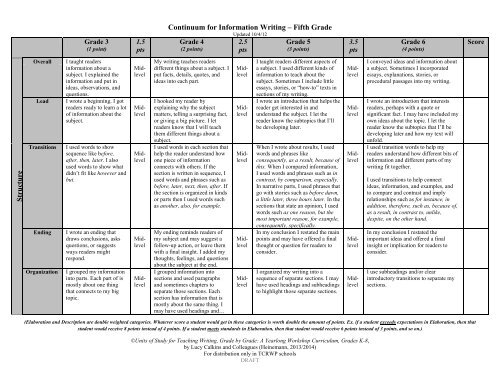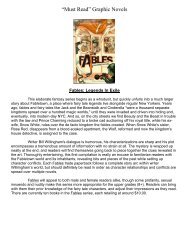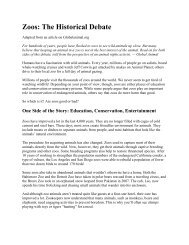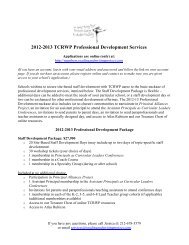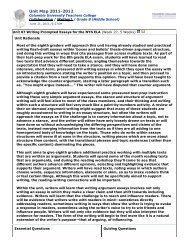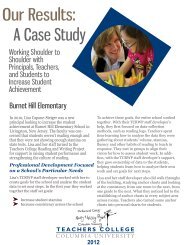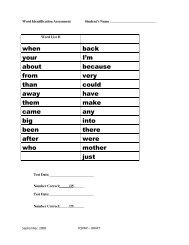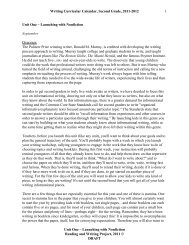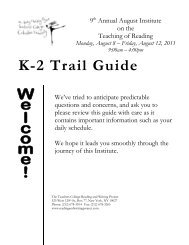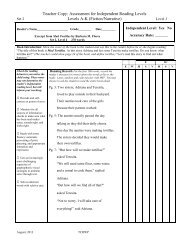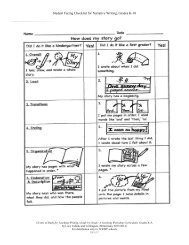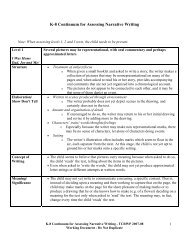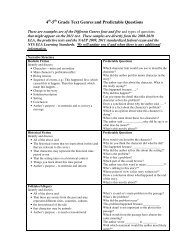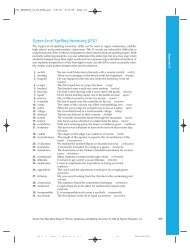Continuum for Information Writing â Fifth Grade S tru cture
Continuum for Information Writing â Fifth Grade S tru cture
Continuum for Information Writing â Fifth Grade S tru cture
You also want an ePaper? Increase the reach of your titles
YUMPU automatically turns print PDFs into web optimized ePapers that Google loves.
<strong>Grade</strong> 3(1 point)1.5pts<strong>Continuum</strong> <strong>for</strong> In<strong>for</strong>mation <strong>Writing</strong> – <strong>Fifth</strong> <strong>Grade</strong>Updated 10/4/12<strong>Grade</strong> 4(2 points)2.5pts<strong>Grade</strong> 5(3 points)3.5pts<strong>Grade</strong> 6(4 points)ScoreS<strong>tru</strong><strong>cture</strong>OverallLeadTransitionsEndingOrganizationI taught readersin<strong>for</strong>mation about asubject. I explained thein<strong>for</strong>mation and put inideas, observations, andquestions.I wrote a beginning. I gotreaders ready to learn a lotof in<strong>for</strong>mation about thesubject.I used words to showsequence like be<strong>for</strong>e,after, then, later. I alsoused words to show whatdidn’t fit like however andbut.I wrote an ending thatdraws conclusions, asksquestions, or suggestsways readers mightrespond.I grouped my in<strong>for</strong>mationinto parts. Each part of ismostly about one thingthat connects to my bigtopic.My writing teaches readersdifferent things about a subject. Iput facts, details, quotes, andideas into each part.I hooked my reader byexplaining why the subjectmatters, telling a surprising fact,or giving a big pi<strong>cture</strong>. I letreaders know that I will teachthem different things about asubject.I used words in each section thathelp the reader understand howone piece of in<strong>for</strong>mationconnects with others. If thesection is written in sequence, Iused words and phrases such asbe<strong>for</strong>e, later, next, then, after. Ifthe section is organized in kindsor parts then I used words suchas another, also, <strong>for</strong> example.My ending reminds readers ofmy subject and may suggest afollow-up action, or leave themwith a final insight. I added mythoughts, feelings, and questionsabout the subject at the end.I grouped in<strong>for</strong>mation intosections and used paragraphsand sometimes chapters toseparate those sections. Eachsection has in<strong>for</strong>mation that ismostly about the same thing. Imay have used headings and…I taught readers different aspects ofa subject. I used different kinds ofin<strong>for</strong>mation to teach about thesubject. Sometimes I include littleessays, stories, or “how-to” texts insections of my writing.I wrote an introduction that helps thereader get interested in andunderstand the subject. I let thereader know the subtopics that I’llbe developing later.When I wrote about results, I usedwords and phrases likeconsequently, as a result, because ofthis. When I compared in<strong>for</strong>mation,I used words and phrases such as incontrast, by comparison, especially.In narrative parts, I used phrases thatgo with stories such as be<strong>for</strong>e dawn,a little later, three hours later. In thesections that state an opinion, I usedwords such as one reason, but themost important reason, <strong>for</strong> example,consequently, specifically.In my conclusion I restated the mainpoints and may have offered a finalthought or question <strong>for</strong> readers toconsider.I organized my writing into asequence of separate sections. I mayhave used headings and subheadingsto highlight those separate sections.MidlevelMidlevelMidlevelMidlevelMidlevelMidlevelMidlevelMidlevelMidlevelMidlevelMidlevelMidlevelMidlevelMidlevelMidlevelI conveyed ideas and in<strong>for</strong>mation abouta subject. Sometimes I incorporatedessays, explanations, stories, orprocedural passages into my writing.I wrote an introduction that interestsreaders, perhaps with a quote orsignificant fact. I may have included myown ideas about the topic. I let thereader know the subtopics that I’ll bedeveloping later and how my text willunfold.I used transition words to help myreaders understand how different bits ofin<strong>for</strong>mation and different parts of mywriting fit together.I used transitions to help connectideas, in<strong>for</strong>mation, and examples, andto compare and contrast and implyrelationships such as <strong>for</strong> instance, inaddition, there<strong>for</strong>e, such as, because of,as a result, in contrast to, unlike,despite, on the other hand.In my conclusion I restated theimportant ideas and offered a finalinsight or implication <strong>for</strong> readers toconsider.I use subheadings and/or clearintroductory transitions to separate mysections.(Elaboration and Description are double weighted categories. Whatever score a student would get in these categories is worth double the amount of points. Ex. if a student exceeds expectations in Elaboration, then thatstudent would receive 8 points instead of 4 points. If a student meets standards in Elaboration, then that student would receive 6 points instead of 3 points, and so on.)©Units of Study <strong>for</strong> Teaching <strong>Writing</strong>, <strong>Grade</strong> by <strong>Grade</strong>: A Yearlong Workshop Curriculum, <strong>Grade</strong>s K-8,by Lucy Calkins and Colleagues (Heinemann, 2013/2014)For distribution only in TCRWP schoolsDRAFT
<strong>Continuum</strong> <strong>for</strong> In<strong>for</strong>mation <strong>Writing</strong> – <strong>Fifth</strong> <strong>Grade</strong>subheadings to tell readers whateach section is about.Updated 10/4/12I wrote each section according to anorganizational plan shaped partly bythe genre of the section.I made deliberate choices about how toorder sections and in<strong>for</strong>mation withinsections. I chose s<strong>tru</strong><strong>cture</strong>s and textfeatures to help me emphasize keypoints.I used transitions, introductions, andtopic sentences to pop out my mainpoints. I wrote multiple paragraphs insome sections.TotalDevelopmentElaboration<strong>Grade</strong> 3(1 point)I wrote facts, definitions,details, observations aboutmy topic and explainedthem.1.5pts<strong>Grade</strong> 4(2 points)I taught my reader differentthings about the subject. I chosethese subtopics because theywere important and interesting. Iincluded different kinds of factsand details like numbers, names,and examples to teach my readerabout the subject.I got my in<strong>for</strong>mation fromtalking to people, reading booksand from my own knowledgeand observations.I made choices aboutorganization. I might have usedcompare/contrast, cause/effect orpro/con. I may have useddiagrams, charts, headings, boldwords, and definition boxes tohelp me teach my readers.2.5pts<strong>Grade</strong> 5(3 points)I explained different aspects of asubject. I included a variety ofin<strong>for</strong>mation like examples, details,dates, and quotes to help me teachthe reader.I used <strong>tru</strong>sted sources and gavecredit when appropriate. I made sureto research any details that seemedimportant to explain to the reader.I might have used differentorganizational s<strong>tru</strong><strong>cture</strong>s within mypiece including stories, essays, andhow-to sections.I worked to make my in<strong>for</strong>mationunderstandable to readers. To dothis, I may have referred to earlierparts of my text, summarizedbackground in<strong>for</strong>mation or raisedquestions. I let readers know when Iwas discussing facts and when I wasoffering my own thinking.3.5ptsMidlevelMidlevelMidlevel<strong>Grade</strong> 6(4 points)I chose a focused subject, included avariety of in<strong>for</strong>mation and organized mypoints to best in<strong>for</strong>m my readers.I used <strong>tru</strong>sted sources and in<strong>for</strong>mationfrom authorities on the topic and gavethe sources credit <strong>for</strong> important excerptsin the text and in a bibliography.I might have used differentorganizational s<strong>tru</strong><strong>cture</strong>s within mypiece including stories, essays, and howtosections.I worked to make my in<strong>for</strong>mationunderstandable and interesting. To dothis, I may have referred to earlier partsof my text, summarized backgroundin<strong>for</strong>mation, raised questions,considered possible implications.Score(x2)(Elaboration and Description are double weighted categories. Whatever score a student would get in these categories is worth double the amount of points. Ex. if a student exceeds expectations in Elaboration, then thatstudent would receive 8 points instead of 4 points. If a student meets standards in Elaboration, then that student would receive 6 points instead of 3 points, and so on.)©Units of Study <strong>for</strong> Teaching <strong>Writing</strong>, <strong>Grade</strong> by <strong>Grade</strong>: A Yearlong Workshop Curriculum, <strong>Grade</strong>s K-8,by Lucy Calkins and Colleagues (Heinemann, 2013/2014)For distribution only in TCRWP schoolsDRAFT
DescriptionI chose expert words toteach readers a lot aboutthe subject. I taughtin<strong>for</strong>mation in a way tointerest readers. I mayhave used drawings,captions or diagrams.<strong>Continuum</strong> <strong>for</strong> In<strong>for</strong>mation <strong>Writing</strong> – <strong>Fifth</strong> <strong>Grade</strong>I made deliberate word choicesto teach my reader. I may havedone this by using and repeatingkey words about my topic.When it felt right to do so, Ichose interesting comparisonsand used figurative language toclarify my points.I made choices about whichin<strong>for</strong>mation was best toinclude/not include to help me toteach my reader.I used a teaching tone. To do so,I may have used phrases likethat means..., what that reallymeans is..., let me explain...Updated 10/4/12I made deliberate word choices tohave an effect on my reader. I usedthe vocabulary of experts andexplained the meaning of importantterms.I worked to include the exact phrase,comparison or image to explainin<strong>for</strong>mation and concepts.Not only did I make choices aboutwhich details and facts to include, Ialso made choices about how to givemy in<strong>for</strong>mation to best teach myreaders. I blended storytelling,summary and other genres as neededand used text features.I used a consistent, inviting teachingtone, and varied my sentences tohelp my reader take in andunderstand the in<strong>for</strong>mation.MidlevelMidlevelMidlevelI chose my words carefully to explainmy in<strong>for</strong>mation and ideas and have aneffect on my reader. I incorporateddomain specific vocabulary andexplained these terms to readers.I worked to include exact phrases,comparisons, analogies and/or images toexplain in<strong>for</strong>mation and concepts andkeep my reader engaged.I chose how to present my in<strong>for</strong>mationto clearly convey why and how thein<strong>for</strong>mation supported my points.I supported readers’ learning by shiftingwithin a consistent teaching tone asappropriate, and I used language andsentence s<strong>tru</strong><strong>cture</strong> that matches with myteaching purpose throughout my piece.(x2)TotalLanguage ConventionsSpellingPunctuation<strong>Grade</strong> 3(1 point)When I wasn’t sure howto spell a word, I usedwhat I know about similarwords or I used tools inthe classroom.I punctuated dialoguecorrectly, with commasand quotation marks.I used punctuation to fixmy run-on sentences.1.5pts<strong>Grade</strong> 4(2 points)I used what I know about wordfamilies and spelling rules tohelp me spell and edit. I usedthe word wall and dictionaries tohelp me when needed.When writing long, complexsentences, I used commas tomake them clear and correct.2.5pts<strong>Grade</strong> 5(3 points)I used what I know about wordfamilies and spelling rules to helpme spell and edit. I used the wordwall and dictionaries to help mewhen needed.I used commas to set offintroductory parts of sentences. (Asyou might know, ...) I used a varietyof punctuation to fix any run-onsentences. I used punctuation to citemy sources.3.5ptsMidlevelMidlevelMidlevelMidlevelMidlevelMidlevel<strong>Grade</strong> 6(4 points)I used resources to be sure the words inmy writing are spelled correctly,including technical vocabulary.I used punctuation such as dashes,parentheses, colons, and semi-colons tohelp me include extra in<strong>for</strong>mation andexplanation in some of my sentencesScoreI wrote in ways that(Elaboration and Description are double weighted categories. Whatever score a student would get in these categories is worth double the amount of points. Ex. if a student exceeds expectations in Elaboration, then thatstudent would receive 8 points instead of 4 points. If a student meets standards in Elaboration, then that student would receive 6 points instead of 3 points, and so on.)©Units of Study <strong>for</strong> Teaching <strong>Writing</strong>, <strong>Grade</strong> by <strong>Grade</strong>: A Yearlong Workshop Curriculum, <strong>Grade</strong>s K-8,by Lucy Calkins and Colleagues (Heinemann, 2013/2014)For distribution only in TCRWP schoolsDRAFT
helped readers read withpauses where they areneeded and with emphasison the important parts.<strong>Continuum</strong> <strong>for</strong> In<strong>for</strong>mation <strong>Writing</strong> – <strong>Fifth</strong> <strong>Grade</strong>Updated 10/4/12TotalTeachers, when this is totally finished, each category will refer to “the writer” rather than “I”. We are giving out these assessments so they can be used immediately, after giving the on demands, andthey can be used with kids <strong>for</strong> self-assessment and setting goals. We have created these continua so you will have your own place to pull together scores of student work.Scoring Guide:In each row, circle the descriptor in the column that matches the student work. Scores in the categories of Elaboration and Description are worth double the pointvalue (2, 3, 4, 5, 6, 7,or 8 instead of 1, 1.5, 2, 2.5, 3, 3.5, or 4).Total the number of points, and track students’ progress by seeing when the total points increase.Total score: _______If you want to translate this score into a grade, you can use the provided table to score each studenton a scale from 0 – 4.Number of PointsScaled Score1-11 111.5-16.5 1.517-22 222.5-27.5 2.528-33 333.5-38.5 3.539-44 4(Elaboration and Description are double weighted categories. Whatever score a student would get in these categories is worth double the amount of points. Ex. if a student exceeds expectations in Elaboration, then thatstudent would receive 8 points instead of 4 points. If a student meets standards in Elaboration, then that student would receive 6 points instead of 3 points, and so on.)©Units of Study <strong>for</strong> Teaching <strong>Writing</strong>, <strong>Grade</strong> by <strong>Grade</strong>: A Yearlong Workshop Curriculum, <strong>Grade</strong>s K-8,by Lucy Calkins and Colleagues (Heinemann, 2013/2014)For distribution only in TCRWP schoolsDRAFT


